Standards for Drinking Water Quality, GB5749-2022
Standard Number: GB5749-2022
Publish Date: 2022-03-15
Implement Date: 2023-04-01
Issued by: the State Administration for Market Regulation of the P. R. China and the National Standardization Administration
Standard Status: Already issued, soon to be implemented
This is GB5749-2022, Standards for Drinking Water Quality, a food quality standard of the People's Republic of China. It is issued by the State Administration for Market Regulation of the People's Republic of China and the National Standardization Administration.
The English version of this standard is translated from the Chinese original GB5749-2022. In case of discrepancies in the translated version, the original Chinese standard GB5749-2022 (Chinese version) shall prevail. This translated version can provide reference for food production enterprises.
Standard Text of GB5749-2022
A. Standard Cover of GB5749-2022
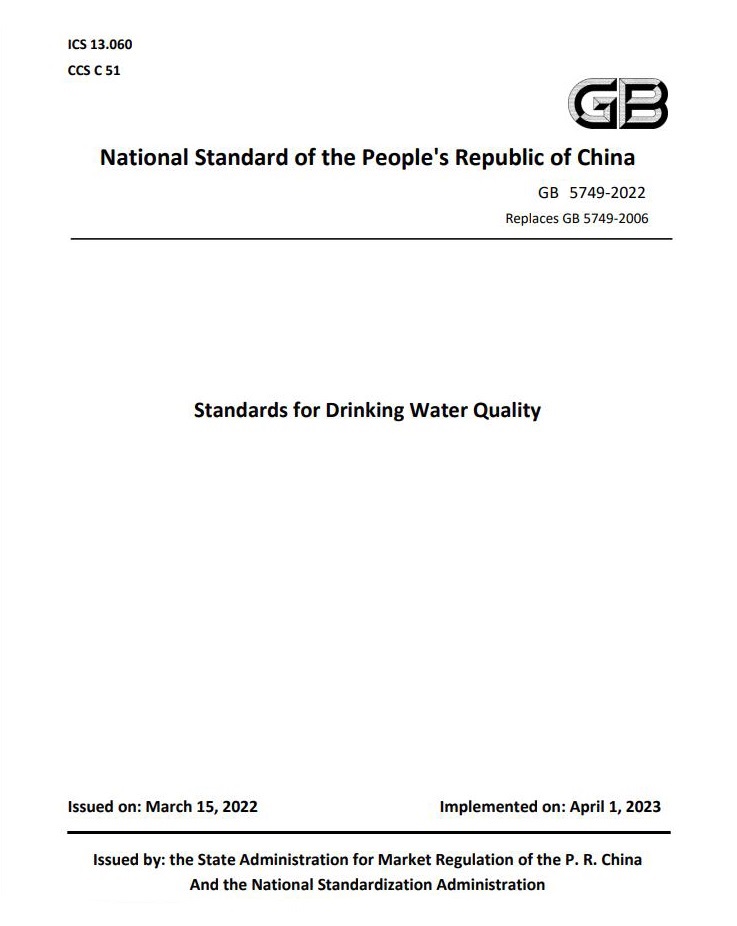 B. Table of contents
B. Table of contents
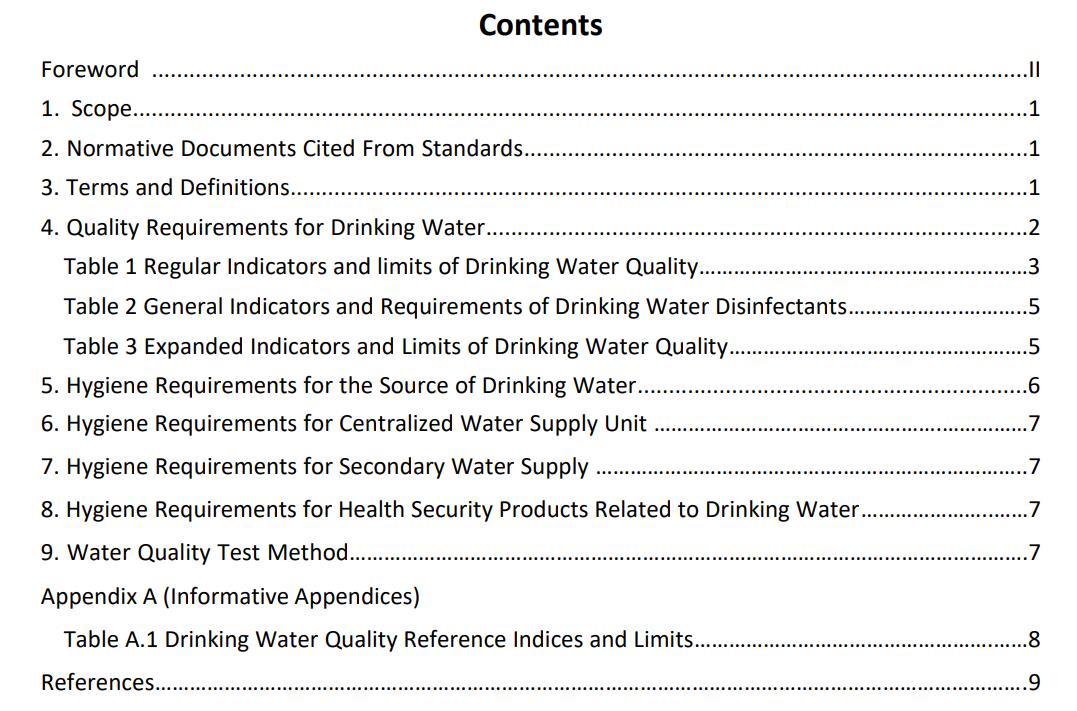
C. Standard Preface of GB5749-2022
Foreword
This document is drafted in accordance with the provisions of GB/T 1.1-2020 "Guidelines for Standardization Work Part 1: Structure and Drafting Rules of Standardization Documents".
This document replaces GB 5749-2006 "Standards for Drinking Water Quality". Compared with GB 5749-2006, except for structural adjustment and editorial changes, the main technical changes are as follows.
a) The water quality indicators are adjusted from 106 items in GB 5749-2006 to 97 items, including 43 regular indicators and 54 extended indicators (see Chapter 4); Amongthem:
• Added 4 indicators, including perchlorate, acetochlor, 2-methyl leftover alcohol, and geosmin.
• Deleted 13 indicators, including heat-resistant coliforms, chloral, sulfide, cyanogen chloride (as CN-), Hexachlorocyclohexane (total), parathion, methyl parathion, Lindane, DDT, formaldehyde, 1,1,1-trichloroethane, 1,2-dichlorobenzene, ethylbenzene.
• Changed the names of 3 indicators, including oxygen consumption (CODMn method, as O2), changed the name to permanganate index (as O2), and changed the name of ammonia nitrogen (as N) to ammonia (as N) , The name of 1,2-dichloroethylene was changed to 1,2-dichloroethylene (total amount).
• Changed the limits of 8 indicators, including nitrate (as N), turbidity, permanganate index (as O2), free chlorine, boron, vinyl chloride, trichloroethylene, dimethoate.
• Added specific requirements for nuclide analysis and evaluation with total beta radioactivity indicator; and the applicability evaluation of microcystin-LR indicator.
• The provisional provisions on water quality indicators and limits for small-scale centralized water supply and decentralized water supply are deleted (see Chapter 4 of the 2006 edition).
b) The water quality reference index was adjusted from 28 items in GB 5749-2006 to 55 items (see Appendix A). Amongthem:
• Added 29 indicators, including vanadium, Hexachlorocyclohexane (total amount), parathion, methyl parathion, lindane, DDT, trichlorfon, thiophanate-methyl, rice blast, trifluralin, Metalaxyl, Xicaojing, Acephate, Formaldehyde, Trichloroacetaldehyde, Cyanogen Chloride (as CN-), Nitrosodimethylamine, Iodoacetic Acid, 1,1,1-Trichloroethane , ethylbenzene, 1,2-dichlorobenzene, perfluorooctanoic acid, perfluorooctane sulfonic acid, dimethyl disulfide, dimethyl trisulfide, iodide, sulfide ,uranium, radium-226.
• Deleted 2 indicators, including 2-methylisoborneol and geosmin.
• Changed the names of 3 indicators, including ethylene dibromide to 1,2-dibromoethane, nitrite to nitrite (as N), and asbestos (>10μm) to asbestos ( Fiber>10μm).
• Changed the limit of one indicator to petroleum (total).
Please note that some content of this document may be patented. The issuing agency of this document assumes no responsibility for identifying patents.
This document is proposed and managed by the National Health Commission of the People's Republic of China.
The previous versions of this document and its superseded documents are as follows:
—— First published in 1985 as GB 5749-1985, first revised in 2006.
—— This is the second revision.
D. Total Pages: 13, (including cover, Table of Contents, preface and contents)
Total Words: 2509, (Table of contents, tables, and images cannot count the words)
E. Standard Content of GB5749-2006
Standards for Drinking Water Quality
1. Scope
The sanitary requirements of the drinking water and its source, centralized water supply unit, secondary water supply and health security products related to drinking water as well as water quality monitoring and testing methods.
This standard applies to drinking water from all kinds of centralized water supply in urban and rural areas, and also applies to decentralized drinking water supply.
2. Normative Documents Cited From Standards
The clauses of the documents mentioned below become clauses of this standard through being cited by this standard. For all documents cited with dates, all modifications (with the exception of error corrections) or modifications are not applicable for this standard, but all parties who conclude the agreement on the basis of this standard are still encouraged to study the possibility of whether or not to adopt the new versions of the aforementioned documents. Documents without dates and their new versions are applicable for this standard.
……
4. Quality Requirements for Drinking Water
4.1 The quality of drinking water should meet the following basic requirements to ensure the safety of users.
a) Pathogenic microorganisms should not be contained in the drinking water.
b) Chemicals in drinking water should not be harmful to human health.
c) Radioactive substances in drinking water should not be harmful to human health.
d) Sensory properties of drinking water should be good.
e) Drinking water should be through sterilization processing.
4.2 The drinking water quality shall meet the requirements in table 1 and table 3. The limits and residual amounts of disinfectant in finished water and tap water should meet the requirements of Table 2.
Note: When drinking water contains the indicators listed in Table A.1 in Appendix A, the limits in this table can be referred to for evaluation.
Table 1 - Regular Indicators and limits of Drinking Water Quality
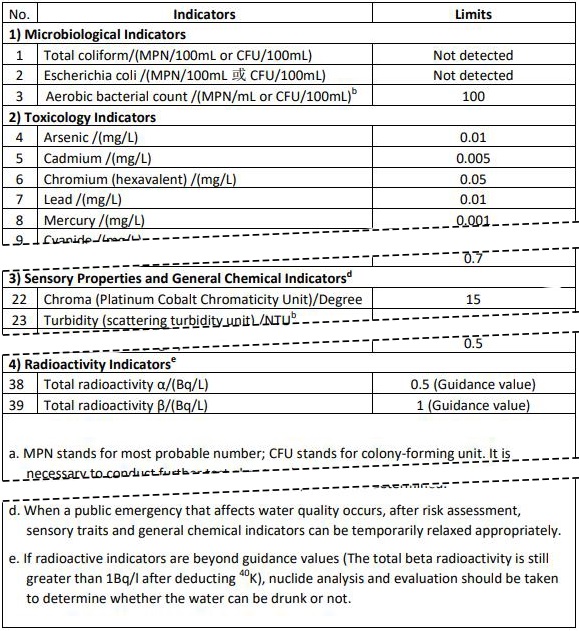
Table 2 - Regular Indicators and Requirements of Drinking Water Disinfectant
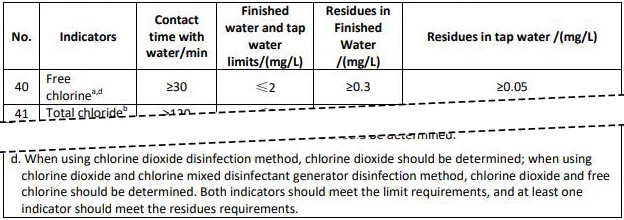
Table 3 - Non-regular Water Quality Indicators and Limit Values
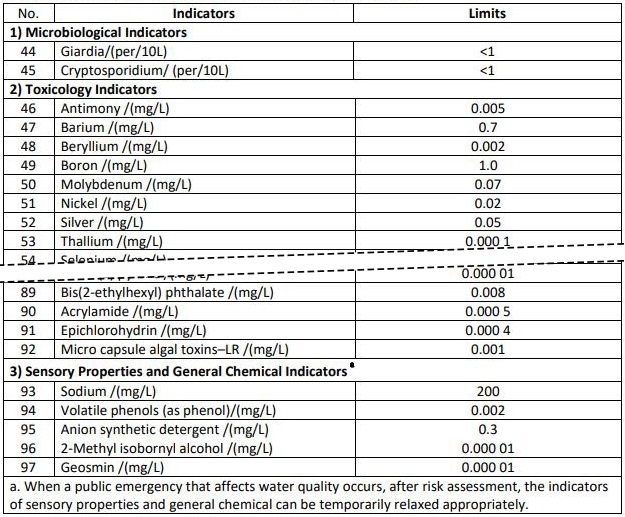
……
Appendix A
(Informative Appendices)
Drinking Water Quality Reference Indices and Limits
Table A.1 - Drinking Water Quality Reference Indices and Limits
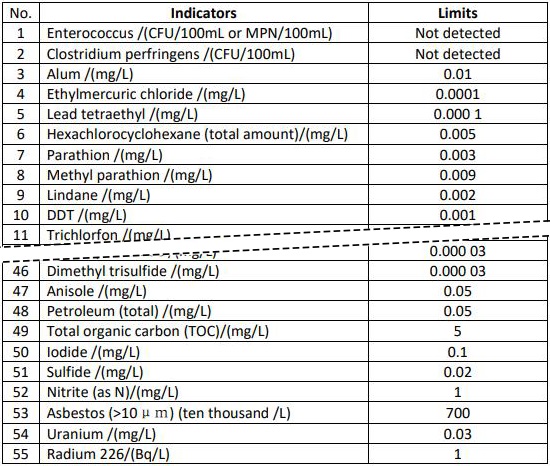
……
______________________________
Note: Commonly used Chinese food standards include mandatory national standards (the code starts with "GB") and recommended national standards (the code starts with "GB/T")
If you need other Chinese standards related to food, please "Contact Us". We do our best to find and provide translation services.
----------------------------------------------------
To obtain the text of this standard (English version), a payment of 80 US dollars ($80) is required. Payment can also be made in RMB, Euro, British pound, Australian dollar, New Zealand dollar, Canadian dollar, Thai baht, Swiss franc, and ruble. Payment can be made by Visa, UnionPay, credit card, debit card, wire transfer, Paypal, Alipay and WeChat. After payment, please tell us your payment name, country and location where payment is made, payment time, and email address for receiving documents in "Contact Us". If you still haven't received the document after 1 day after payment, please "contact us" so that we can solve it in time. When the document is received, please reply "Document received". If there is no response within 10 days, we consider the document to have been received. You can also ask for help through "Contact Us".
----------------------------------------------------
References Articles
1. GB17323-1998 Bottled Purified Water for Drinking
2. GB19298-2014 Packaged Water for Drinking
3. GB8537-2018 Drinking Natural Mineral Water
4. GB/T6682-2008 Water for Analytical Laboratory Use - Specifications and Test Methods
5. GB5009.16-2014 Determination of Tin in Food 1 - National Food Safety Standard
6. GB5009-268 Determination of Multiple Elements in Food 1
7. GB14881-2013 General Hygienic Regulation for Food Production
8. GBT/27341-2009 Hazard Analysis and Critical Control Point (HACCP) System - General Requirements for Food Processing Plant
----------------------------------------------------
Related Equipment
1. River and Lake Drinking Water Purification Treatment Equipment: can treat raw water of rivers and lakes into drinking water, is ideal drinking water purification treatment equipment for a water plant.
2. Well and Mountain Water Purification Treatment Equipment for Drinking: The water purification treatment equipment can treat raw water of well and mountain into drinking water, have no RO equipment, automatic backwashing, and large processing capacity.
3. Food Safety Testing and Inspection instruments Equipment: are used for inspection of pesticide residues, heavy metals.
4. Microbiology Testing Equipment and Instruments: include incubators, gadgets, and instruments, are one of the food safety testing equipment.
5. Laboratory Equipment and Instruments: include precision weighing equipment, evaporators, drying ovens and food testing instruments.
6. Food Production Monitors and Online Detectors: are capable of detecting and monitoring the quality of each product on the food production line, is important testing equipment.
---------------------------------------------------- 




